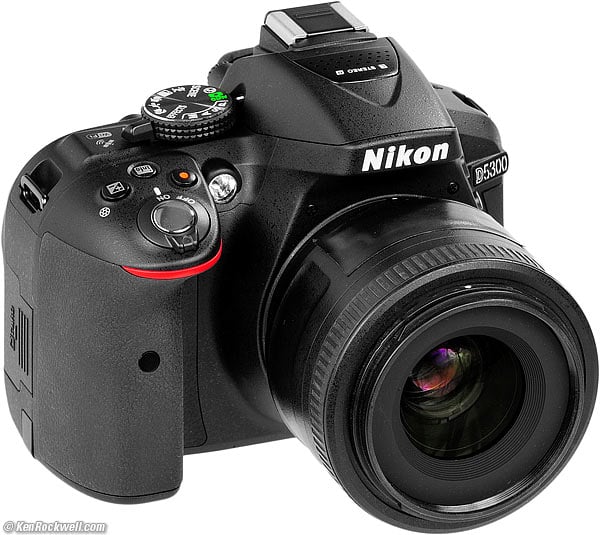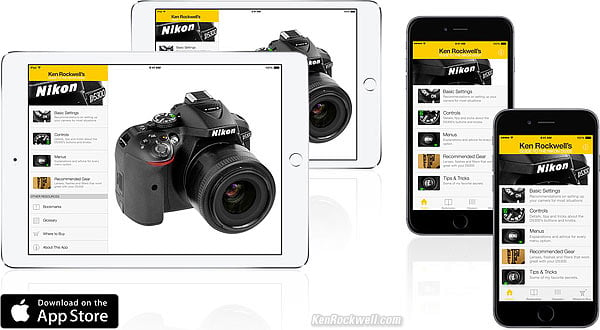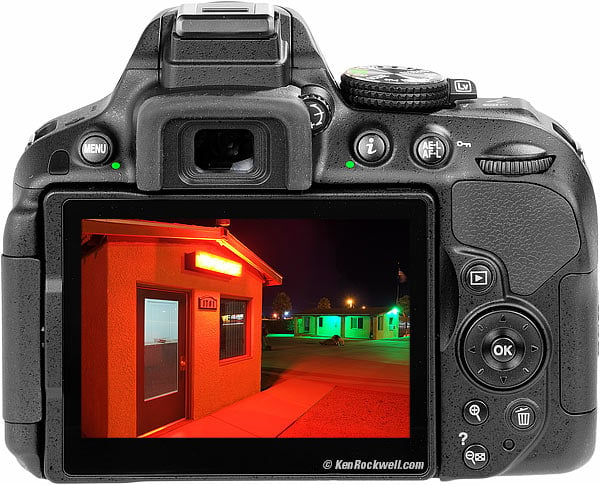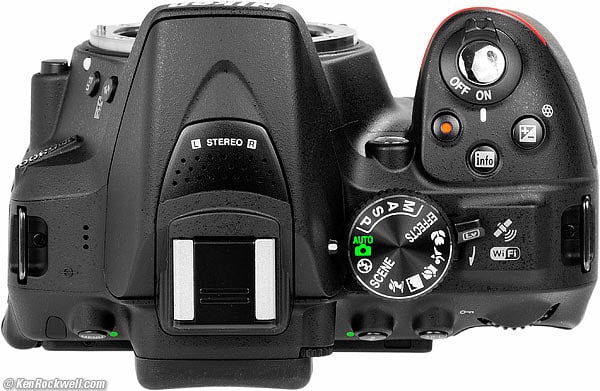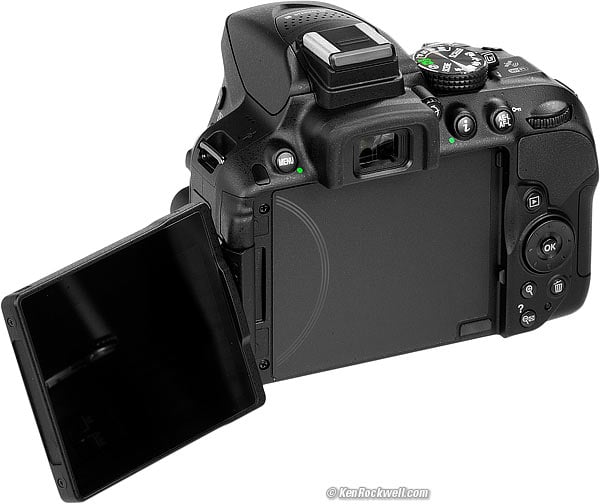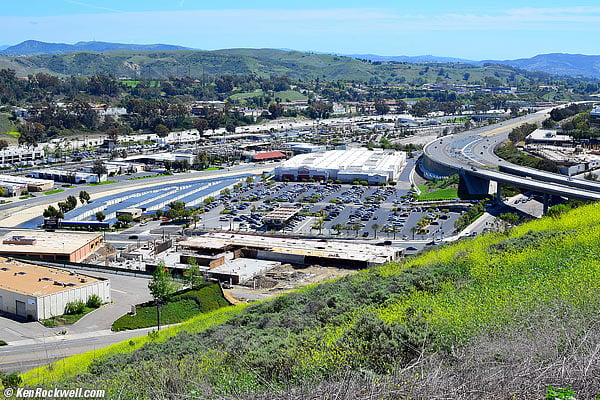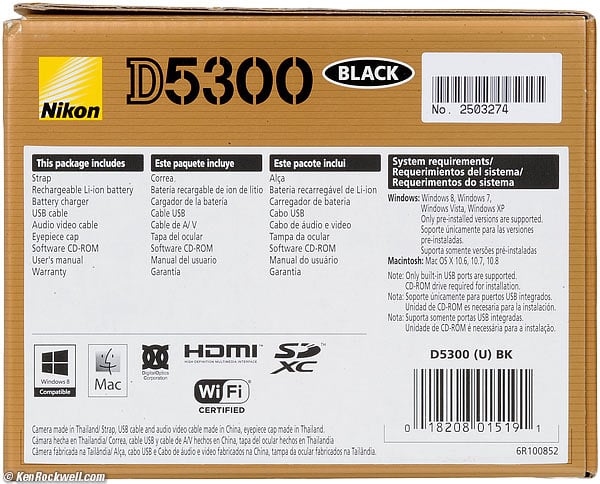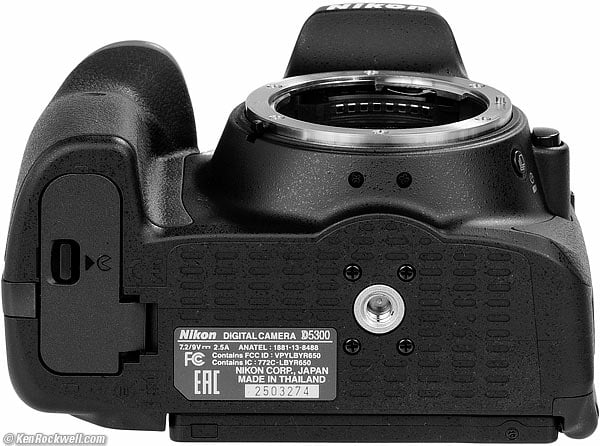Home Donate New Search Gallery Reviews How-To Books Links Workshops About Contact
Nikon D5300
24 MP, 5 FPS, Flip LCD, Wi-Fi & GPS
© KenRockwell.com. All rights reserved.
Intro Specs Performance Compared Recommendations More
Nikon D5300 and 35/1.8 DX (18.8 oz./532 g body-only with battery and card, about $697 body-only, $796 w/18-55mm VR or $997 with 18-140mm lens; also comes in numerous colors and kit forms). enlarge. My biggest source of support is when you use those or any of these links, especially this link directly to it at Adorama or directly to it at Amazon, when you get anything, regardless of the country in which you live. Thank you! Ken.
January 2015 More Nikon Reviews Nikon Lenses All Reviews
NEW: Nikon D5500. January 2015
NEW: Ken Rockwell's Nikon D5300 Users Guide app.
Nikon D5300 Plain-English User's Guide 04 April 2014
Nikon D5300 Autofocus System User's Guide 04 April 2014
Rear, Nikon D5300. enlarge.
Top, Nikon D5300. enlarge.
Flip screen, Nikon D5300. enlarge.
Nikon D5300. enlarge.
Sample Image Files
Stone, 21 March 2014. Nikon D5300, Nikon 35mm f/1.8 DX, f/9 at 1/320, ISO 100, VIVID Picture Control. © Camera-original LARGE BASIC JPG file.
Flowers, 22 March 2014. Nikon D5300, Nikon 35mm f/1.8 DX, f/8 at 1/125, ISO 100, VIVID Picture Control, +3 Saturation, Perfectly Clear. © Full-resolution file from BASIC LARGE JPG.
Flowers, 22 March 2014. Nikon D5300, Nikon 35mm f/1.8 DX, f/8 at 1/125, ISO 100, VIVID Picture Control, +3 Saturation, Perfectly Clear. © Full-resolution file from BASIC LARGE JPG.
Is it sharp? 30 March 2014. Nikon D5300, Nikon 35mm f/1.8 DX, f/8 at 1/250 at ISO 100, VIVID Picture Control, +3 Saturation. Bigger or © camera-original BASIC LARGE JPG. It's so sharp that the biggest sharpness limitation is the heat shimmer of the distant view!
Introduction top
Specs Performance Compared Recommendations More
The Nikon D5300 offers fantastic DSLR image quality and speed in an ultralight and inexpensive package. Live View lets you shoot photos and videos while held away from your head with a swiveling screen.
The D5300 adds GPS, Wi-Fi, even lighter weight and a slightly larger LCD screen over last year's model, the D5200. The D5300 now also comes in grey or red.
The D5300 weighs so little that it's a pleasure to carry everywhere, and the D5300 is capable of capturing stunning images. Compared to pro cameras I often haul, the D5300 is a dream to carry, and if I'm more relaxed, I make better pictures.
This D5300 has higher resolution than the $6,500 Nikon D4s, and its pictures are otherwise the same — and the D4s has no swivel screen! The D5300's shutter is much quieter than the D4s; you can shoot the D5300 in places where the loud D4s shutter would get you thrown out. The AF areas of the D5300 also fill more of its frame than they do in the D4s!
The only reason to pay more (and lug more) than the D5300 is if you subject your camera to daily physical and environmental abuse, or if you're an expert photographer who actually uses and understands advanced adjustments.
The D5300 has the same advanced adjustments as Nikon's more expensive cameras, but often requires you stop and go into a menu where the fancier cameras like the D7100 will have a dedicated button for the same thing, saving time — but only if you actually use those adjustments. On the other hand, for normal people the D5300 has its exposure modes on a big dial on top, while the D4s demands you hold a button and spin a knob to do the same thing, and the D5300 also has modes like "Macro," Sports" and "Portrait" on its big dial, while the pro cameras don't even have these modes.
For most people, the D5300 is a better camera than Nikon's more expensive models precisely because the D5300 is designed for normal people, not for full-time pros. The picture quality is the same.
If you just want great photos easily, the D5300 can't be beat. If you are like me and are constantly resetting the camera from shot to shot as conditions change (very few people know how to do any of this), I prefer the D7100 because it has more buttons to do directly what has to be done in menus on the D5300, while the D5300 weighs less and takes exactly the same pictures as the D7100.
Good
Superb image quality
Excellent built-in flash
Fast and competent autofocus
Super light weight
Fast handling
Missing
Compared to a professional D4s for $6,500, the things missing are things most people won't miss:
No one-click playback zoom (pressing (+) only zooms in a little, not all the way).
No depth-of-field preview button.
No voice notes (used by reporters to record spoken notes with the images)
No battery percentage number, just a three-bar battery icon.
No auto LCD brightness control, but I never missed it.
No easy way to set Auto ISO ON/OFF or image size etc. directly; you have to stop and look at the menus or control panels.
Built-in flash can't work as a commander for wireless flash.
No second memory card slot.
For $5,700 less than the D4s, I think I'll live, and the D5300 has a built-in flash sorely lacking in the D4s.
Lens Compatibility
Today's Lenses(AF-S)
Like other inexpensive Nikons like the D5200, D5100, D5000, D3300, D3200, D3100, D3000, D60, D40 and D40x, everything works flawlessly with all modern AF-I and AF-S lenses.
Nikon is not expecting people who buy the D5300 to use it with ancient lenses, and therefore saves everyone the expense and weight of including the parts needed in more expensive cameras to ensure compatibility with the older lenses below.
Modern AF-S and DX lenses are the best lenses for the D5300. I own and have used older lenses on my D5300, and they aren't as good optically or ergonomically.
If you insist, here's what happens:
1980s AF Lenses (screw-focus)
Unlike heavier DX and FX cameras, the D5300 has no internal autofocus motor, so it will not autofocus with old-style screw-drive autofocus (AF) lenses.
Everything else works perfectly with older-style AF lenses, except that you'll have to turn the focus ring manually and look either for a sharp viewfinder image or the electronic focus confirmation dot at the bottom of the finder.
Manual Focus Lenses (Non-CPU, 1959-today)
The D5300 gives you a dumb "Lens not attached" warning with old manual-focus lenses — unless you set the top dial to M (manual).
If set to Manual, you can shoot all you want. Focus by looking for a sharp image on the finder screen, or look for the green "AF OK" dot at the lower left.
It offers no metering with manual-focus lenses, but there are workarounds like looking at the LCD after you shoot, or using a separate light meter like the Gossen Digisix.
Live View works with manual lenses, but only if the mode dial is set to M. Oddly even through the live view is always exposed well, you'll still have to guess at the correct manual exposure setting.
See more details at Nikon Lens Compatibility.
Specifications top
Intro Specs Performance Compared Recommendations More
Sensor
DX (23.5 x 15.6 mm) CMOS.
Sensor cleaner.
Image Sizes
6,000 x 4,000 pixels native (LARGE, 24 MP).
4,496 x 3,000 (MEDIUM, 13.5 MP).
2,992 x 2,000 (SMALL, 6 MP).
File Formats
NEF (12- or 14-bit compressed raw), JPG, or both.
ISO
Auto: ISO 100 - 12,800.
Auto ISO allows setting the slowest speed as well as minimum and maximum ISOs, as well as setting the slowest speed to set itself automatically to the lens focal length, and you may then set that speed to vary ±2 stops from the focal length. In other words, the D5300 has the best and most flexible Auto ISO settings in the business.
Manual: ISO 100 - 25,600. Above ISO 12,800 it reads as H+0.3, H+0.7 and H+1.
Finder
95% coverage.
0.46x magnification with standard 28mm lens (0.82x magnification with 50mm telephoto lens).
-1.7 to +1.0 diopters.
18 mm eyepoint.
Meter
2,016 pixel RGB meter sensor.
3D Color Matrix, center-weighted and spot.
AF
39 points, also settable to only 11.
Nikon Multi-CAM 4800DX sensor module from the D7000.
AF-S (single). AF-C (continuous), and AF-A (auto selection between the other two modes).
Single-point AF, Dynamic AF, Auto Area AF.
AF illuminator.
LV -1 to +19.
Shutter
1/4,000 to 30 seconds in 1/3 or 1/2 stops, bulb.
Maximum speed with flash ( sync speed) 1/200.
Up to 5 FPS.
QUEIT mode selectable in a menu.
Optional Remotes
ML-L3 (get one!)
Wireless remote controller WR-R10.
Remote cord MC-DC2.
Flash
i-TTL metering.
Works only with SB-910, SB-900, SB-800, SB-700, SB-600 and SB-400.
1/200 sync speed.
Built-in Flash
Built-in TTL flash.
GN 12 meters/39 feet.
Optional manual control in a menu.
Does not work as an i-TTL commander.
Video
1,920 x 1,080 at 59.94p, 50p, 29.97p, 25p or 23.976p.
1,280 x 720 at 59.94p or 50p.
Non-standard (cropped) 640 x 424 at 25/30p 29.97p or 25p.
Up to 30 minutes per take, 20 minutes in 1080 50 or 60 p or only 3 minutes in "miniature" mode.
H.264/MPEG-4 stored as .MOV files.
Nikon claims Full-Time AF, but I seriously doubt AF works well.
Stereo mic built in.
LCD
3.2" swivel.
720 x 480 pixels (1,037,000 R, G or B dots).
170º viewing.
Storage
SD memory card, one slot.
SDHC-, SDXC- and UHS-I compliant.
Approved brands
Nikon approves only some SanDisk, Lexar, Toshiba and Panasonic cards.
DO NOT tempt fate with no-name cards.
Connectors
Type C mini-HDMI.
NTSC or PAL analog A/V via a proprietary connecter.
Proprietary remote connector.
3.5mm stereo mic input.
Power
EN-EL14a rechargeable Li-ion battery (similar to the EN-EL14 of the D5200, D5100, D3100 and P7000).
Battery weight: 1.700 oz. (48.1 g.), measured.
Optional EH-5a AC adapter. (requires EP-5B power connector.)
Environment
0~40ºC (32~104ºF).
Up to 85% RH.
GPS
1,575.42 MHz (C/A code).
Geodesics: WGS84.
Wi-Fi
IEEE 802.11b: DSSS/CCK.
IEEE 802.11g: OFDM.
2,412 to 2,462 MHz (channels 1 to 11).
54 MBPS.
Size
5.1 x 3.9 x 3.1 inches.
129 x 98 x 78 millimeters.
Weight
18.750 oz. (531.5 g), actual measured weight with battery and card.
Battery alone: 1.700 oz. (48.1 g), actual measured weight.
Nikon rates the D5300 at 18.7oz. (530 g) with battery and card.
Nikon rates the D5300 at 16.9 oz. (480 g) stripped naked.
Included
(Maybe a lens if you buy a kit)
D5300 Body
BS-1 Hot Shoe Cover
BF-1B Body Cap
DK-5 Eyepiece Cap
DK-25 Rubber Eyecup
AN-DC3 Strap
EN-EL14a Battery
MH-24 charger
UC-E17 USB cable
EG-CP16 Audio video cable
ViewNX 2 CD-ROM (don't waste your time).
Announced
17 October 2013.
Promised for
November 2013.
Shipping Since
November 2013.
Price, USA
2015 January: $697 ($796 w/18-55mm VR, $997 w/18-140mm VR).
2014 March: $799 ($896 w/18-55mm VR, $1,096 w/18-140mm VR).
2013 October: $799 ($1,400 w/lens).
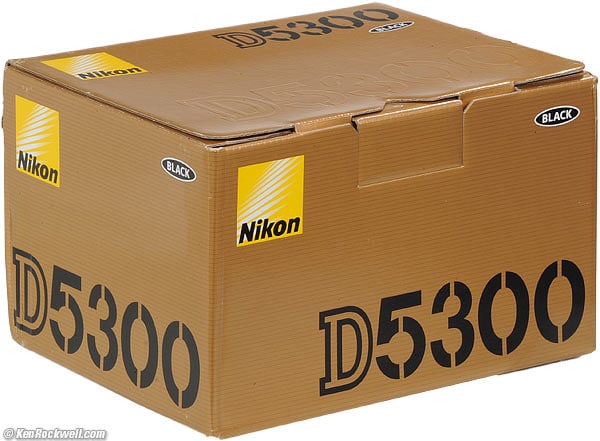
Box, Nikon D5300.
USA Version (applies in USA only)
In the USA, be sure your box has a "(U)" after D5300 above the UPC bar code. If it's another letter, you got ripped off with a gray market version from another country.
Box End, Nikon D5300. bigger.
Performance top
Intro Specs Performance Compared Recommendations More
Overall
The D5300 is an excellent camera with outstanding image quality that weighs next to nothing. Bingo!
The images are fantastic, with so much resolution that the D5300 can push many lenses to their limits, however for advanced users, the D5300 hides too many adjustments behind a menu system instead of providing real buttons.
Autofocus
The AF points fill most of the frame, which is much better than any "full-frame" DSLR.
The default settings are great: the D5300 figures out what sensors and how to use them, and just focuses. It's fast, accurate and easy.
To set anything about the AF system, you have to revert to the menu system. Even to change from automatic AF area selection to manual selection, you have to set it by pushing buttons and looking at the camera's rear screen.
It's swell in the dark. If it's too dark, the AF illuminator helps at most distances.
I don't see any real face detection going on; if a face is behind something the D5300 usually focuses on the something in its default Auto AF Area Select mode.
Finder
The finder image is small, but bright and very sharp.
It uses a lightweight mirror (not heavy glass) prism. The image in the D7100 is bigger due to its heavier glass prism.
Active AF areas are LCDs that turn black. In the dark, they are side-lit in red.
Ergonomics
The D5300 is super lightweight, but often forces advanced users to piddle in menus to make basic settings that could have been done more directly on a higher model camera.
It's great that all the buttons except MENU button are on the right side, making one-handed shooting and playback easy.
Menu setting requires two hands: left hand to hit MENU, and right hand to do all the rest.
Shutter
The shutter is a dream. It's smooth, refined and quiet. For use in sensitive areas, the D5300 is much quieter than the bigger and more advanced Nikons.
The QUEIT [ Q ] mode isn't. All it does is prevent the mirror from flipping back down and the shutter from recharging until after you release the shutter button. This means that the finder goes black until you take your finger off the shutter button, at which time it also makes more noise. It's not much quieter than the regular mode, but a big pain to use. This is OK< since the D5300 is very, very quiet in its regular mode. I'd forget about the [ Q ] mode, which is set in the menu system.
If you want other times than 10 second self timer delays, Nikon hid them at Custom Function C3, where you have your choice of 2s, 5s, 10s or 20 second delays, as well as can set it to your choice of from one to 9 shots when the delay is over.
Exposure
Exposure at the default setting is usually excellent, regardless of conditions. Nikon has gotten better with each new generation.
Color
Color rendition is superb, similar to other modern Nikon DSLRs at the same settings.
Color is as good as Canon, and much better overall than from lesser brands like LEICA, Sony and Fuji. Fuji is superb for people photos, while Nikon and Canon excel for nature and landscape, as well as people pictures.
A significant advantage to Nikon and Canon over other brands is that each is so big that they have spent loads of time and money perfecting their delicate color balances, so the pictures from all their cameras, even the least expensive, look fantastic. You'd think it's simple, but it's not, and other brands lack the color quality of Nikon and Canon. Color quality (making pictures that just look great) has nothing to do with simple color accuracy, which is easy to measure. Color quality is art, and art is never easy.
I don't see any of the color bias I sometimes see in Nikon's 2012 FX cameras, the D600, D800 and D4, so to my sensitive eyes, the D5300's photos are usually better than those from the more expensive FX cameras!
Auto White Balance
Auto White Balance (AWB) works pretty well.
It works extremely well under bright halogen light, giving perfect results.
Under crappy fluorescent lights, it is usually too green, as are most cameras.
Sharpness
24MP images are as sharp as usual. I prefer setting Sharpening (in Picture Controls) to about 7.
At smaller sizes, the images become even sharper pixel-to-pixel, which is excellent. Older Nikons used to have images that didn't get any sharper when set to smaller pixel sizes, which they should because Bayer interpolation goes away.
High ISOs
High ISOs look great. I see no significant noise at ISO 6,400, which is all I need.
Even at ISO 12,800 and ISO 25,600 (Hi + 1.0) are very usable. They aren't that noisy at all; the image gets softer, duller and grungier but not obviously noisy. The noise reduction does a fantastic job of removing any obvious speckles or streaks.
If you have to use the crazy-high ISOs, do it. They look fine.
Built-in Flash
The built-in flash is excellent. Recycling is fast and exposure is usually dead-on, as we expect from Nikon.
The flash is a real winner; I see significant reason for an external flash unless you're a wedding and event photographer and need the extra (camera) battery life.
The built-in flash will not operate as a commander to control other flashes. It only works in the usual TTL mode as well manually.
HDR
HDR, set in a menu, works well. The results are much more natural than the non-HDR shot when in unfavorably harsh light.
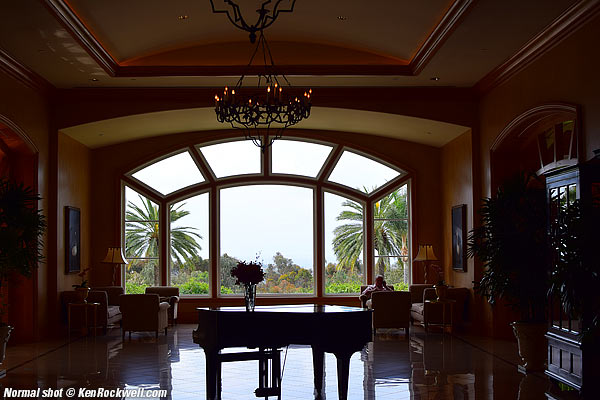
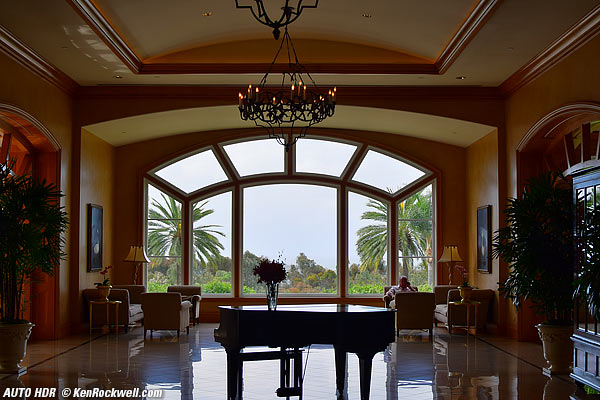
HDR hand-held; no tripod neeeded.
Movies
The D5300 has a built-in stereo mic for real S-t-e-r-e-O sound!
Autofocus while rolling video isn't very fast, typical for a DSLR.
LCD
The big 3.2" LCD is excellent.
It has so many pixels that one never sees any of them to make the screen look grainy, and the D5300's LCD's colors match my calibrated 30" Apple Cinema Display.
It's a 3:2 aspect ratio display, so the full image fills the full screen.
Mechanical Quality
Bottom, Nikon D5300. bigger.
Made in Thailand.
Everything except the lens mount and tripod socket is plastic.
It's very good plastic, and keeps it super light weight. I have no problems with the D5300; it's a very well made camera; much better than the Sonys I've had whose buttons get sticky after a few months.
Power and Battery
As expected, shots-per-charge life is long, much longer than "mirrorless" cameras. It probably runs 1,000 shots per charge; I've never ran down a battery to know!
The charger is a small one with a folding plug, at least in my USA model. The charge light blinks slowly while charging, and goes steady when full.
Playback
Playback is great, and I can hit the PLAY and ZOOM buttons while shooting with one hand.
I can scroll diagonally.
There is an odd programming defect where when the image pops up right after shooting it (Image Review), that turning the rear dial makes the control screen pop up, instead of showing us the other photos. Press the PLAY button and everything works fine with the rear dial, or use the LEFT and RIGHT buttons during Image Review to see other shots.
Data
Cards are correctly titled as "NIKON D5300."
Compared top
Intro Specs Performance Compared Recommendations More
| Anni | 2013- |
2012- |
2011-2012 |
2009-2011 |
| Resolution* | 24MP |
24MP |
16MP |
12MP |
| FPS | 5 FPS |
5 FPS |
4 FPS |
4 FPS |
| Flippy LCD** | 3.2" 1.04m dots |
3" 921k dots |
3" 921k dots |
2.7" 230k dots |
| Max Video rez & rate*** | 1080/29.97p |
1080/29.97p |
1080/29.97p |
720p/23.976p |
| Audio (built-in) **** | Stereo |
Stereo |
mono |
mono |
| AF ***** | 39 points |
39 points |
11 points |
11 points |
| Flash Sync | 1/200 |
1/200 |
1/200 |
1/200 |
| Live View | yes |
yes |
yes |
4 modes |
| GPS | yes |
no |
no |
no |
| Wi-Fi | yes |
no |
no |
no |
| Battery | EN-EL14a |
EN-EL14 |
EN-EL14 |
EN-EL9a |
| Weight | 18.8 oz. 532 g |
19.6 oz. 555 g |
19.5 oz. 554g |
21.6 oz. |
* this is the same; anything more than 6 MP is more than enough for anything. Picture quality is NOT dependant on resolution; today that's just a specification used to scare people into paying more for the latest camera.
** the D5300 and D5100 have very sharp, smooth and detailed images, while the fewer dots of the D5000's LCD make it look a little bit more grainy, but even the D5000 has a perfectly fine LCD.
*** Again probably irrelevant; there won't be much if any visible difference with more resolution here; the biggest difference is that the newer cameras make much bigger files that take up a lot more room on your card and hard drive!
**** If playing back on a home theater system or a computer with stereo speakers, stereo sound makes a huge difference in sound quality over the mono mic of the older D5100 and D5000.
***** The 39 point system is nice, but the 11 point system works great, too. Heck, Nikon's top pro cameras until 2007 all had only 11 points or less, and no one complained!
Recommendations top
Intro Specs Performance Compared Recommendations More
The Nikon D5300 is a fantastic camera. It's small, light, competent and can make breathtaking images in any light. Colors are fantastic, and it focuses and works well in dim light with crazy ISOs unheard of just a few years ago.
Even if you don't need the GPS or Wi-Fi features new in the D5300, it weighs less than last year's model, the D5200. If you're on a bargain hunt, Adorama sometimes has refurbished Nikon D5100 (the even older 2011 model) as a kit with 18-55mm VR for just $429 and body-only for a mere $359.
If you're a seasoned photographer who wants more knobs and buttons for faster control, go for the heavier D7100. If you don't need the flippy screen, the D3300 weighs even less. All of these will make the same superb photos if you know what you're doing, and if you're not an expert photographer, no camera is going take any better or worse pictures for you! The finer points of camera performance, like the finer points of a Steinway versus a Bösendorfer piano, are only apparent or significant to virtuosi.
Here's another hint: the only real reason to pay over twice as much for a heavier Full Frame FX D610 and its bigger lenses is to get a bigger viewfinder! The pictures are the same! There is very little difference in picture quality between full frame FX and these DX cameras. In fact, the biggest picture difference is that DX cameras like this D5300 always get more in focus (have a deeper depth-of-field), while full-frame FX cameras like the D610 get less in focus under similar conditions. Colors, sharpness and noise are the same today; these cameras are all that good.
Lenses
For the D5300, as with all DX cameras, I love my 35mm f/1.8 DX and don't use the 18-55mm VR kit zoom. I'd get a D5300 body-only and the 35mm f/1.8 DX separately.
If you need a telephoto to get closer, I use the 55-200mm VR. The 55-300 VR gets even closer, but costs more.
Ultrawide lenses are expensive. If I need to get wider than the 18-55mm VR, I use my Nikon 10-24mm DX.
Suggested Nikon DX lenses for the D5300.
More Nikon lens reviews and recommendations.
Flash
The built-in flash is excellent.
If you need something better, the small but discontinued SB-400 is what I use. They're easy to get on eBay or at Amazon. You don't need bigger flashes unless you're trying to shoot sports at long distances and at high frame rates, which you probably aren't doing with a D5300.
More Information top
Intro Specs Performance Compared Recommendations More
Help me help you top
I support my growing family through this website, as crazy as it might seem.
The biggest help is when you use any of these links when you get anything, regardless of the country in which you live. It costs you nothing, and is this site's, and thus my family's, biggest source of support. These places have the best prices and service, which is why I've used them since before this website existed. I recommend them all personally.
If you find this page as helpful as a book you might have had to buy or a workshop you may have had to take, feel free to help me continue helping everyone.
If you've gotten your gear through one of my links or helped otherwise, you're family. It's great people like you who allow me to keep adding to this site full-time. Thanks!
If you haven't helped yet, please do, and consider helping me with a gift of $5.00.
As this page is copyrighted and formally registered, it is unlawful to make copies, especially in the form of printouts for personal use. If you wish to make a printout for personal use, you are granted one-time permission only if you PayPal me $5.00 per printout or part thereof. Thank you!
Thanks for reading!
Mr. & Mrs. Ken Rockwell, Ryan and Katie.
Home Donate New Search Gallery Reviews How-To Books Links Workshops About Contact

